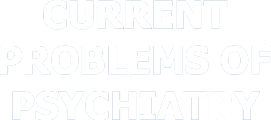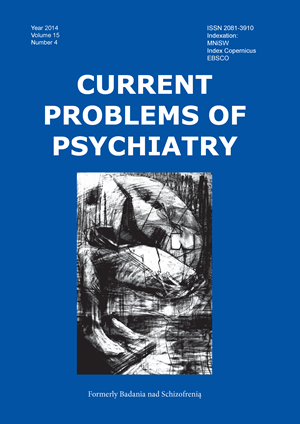Rola oksytocyny w mechanizmie powstawania przywiązaniaoraz w społecznym funkcjonowaniu osób chorych na schizofrenię
Słowa kluczowe:
oksytocyna, schizofrenia, style przywiązania, zachowania społeczneAbstrakt
Celem artykułu jest przedstawienie na podstawie dostępnej literatury znaczenia oksytocyny dla różnych funkcji psychicznych, ze szczególnym uwzględnieniem mechanizmów powstawania przywiązania, stylów przywiązania w schizofrenii oraz wpływu oksytocyny na przebieg i obraz kliniczny schizofrenii. Na wstępie dokonano ogólnego opisu oksytocyny, z uwzględnieniem źródła jej powstawania oraz jej funkcji, na przykładzie badań z dziedziny neuroekologii oraz neuropsychologii. Przedstawiono również biologiczne podstawy przywiązania, opisano style przywiązania oraz ich znaczenie w społecznym funkcjonowaniu osób z wybranymi zaburzeniami psychicznymi. Posłużono się w tym celu badaniami opartymi na modelach zwierzęcych, badaniach ludzi i kliniczną analizą wybranych form zaburzeń przywiązania. Odniesiono się również do wpływu wczesnych doświadczeń społecznych na wybrane parametry mózgowe. Następnie przedstawiono badania dotyczące wpływu oksytocyny na przebieg i obraz kliniczny schizofrenii oraz możliwości i ograniczenia wykorzystania tego hormonu w terapii zaburzeń psychotycznych. Współczesne badania nad terapeutycznym zastosowaniem oksytocyny i jej wpływem na mechanizm powstawania więzi społecznych wydają się być bardzo obiecujące, mogąc przyczynić się do wzrostu efektywności leczenia schizofrenii jak i innych zaburzeń, w których dochodzi do obniżenia funkcjonowania społecznego.
Bibliografia
1. Dale H. The Action of Extracts of the Pituitary Body. Biochem J. 1909; 4: 427–447.
2. Lee HJ., Macbeth AH., Pagani JH., Young WS. Oxytocin: the great facilitator of life. Prog. Neurobiol. 2009; 88 (2): 127–51.
3. Bartz JA., Hollander E. Oxytocin and experimental therapeutics in autism spectrum disorders. Progress in Brain Research. 2008; 170: 451-62.
4. Gibson, Clare Marks. An investigation of the effects of oxytocin on social cognition and social functioning in schizophrenia. Diss. The University of North Carolina at Chapel Hill. 2012.
5. McQuaid, Robyn J. Making room for oxytocin in understanding depres-sion. Neuroscience & Biobehavioral Reviews. 2014; 45: 305-322.
6. Lawson, Elizabeth A.Oxytocin secretion is associated with severi-ty of disordered eating psychopathology and insular cortex hypoactivation in anorexia nervosa. The Journal of Clinical Endo-crinology & Metabolism. 2012; 97(10): 1898-1908.
7. Ganong W. Fizjologia. Warszawa: PZWL; 2007, s. 240.
8. Konturek S. Wydzielanie wewnętrzne. W: Traczyk W., Trzebski A. Fizjologia człowieka z elementami fizjologii stosowanej i klinicz-nej. Wyd. III. Warszawa: PZWL; 2007, s. 343-345.
9. Wójciak P., Remlinger- Molenda A., Rybakowski J. Rola oksytocyny i wazopresyny w czynności ośrodkowego układu nerwowego i w za-burzeniach psychicznych. Psychiatr. Pol. 2012; 46 (6): 1044- 1046.
10. Insel TR., Young LJ. The neurobiology of attachment. Nat. Rev. Neurosc. 2002; 2: 129-136.
11. Churchland P.S., Winkielman P. Modulating social behawior with oxytocin: how does it work? What does it mean? Horm. Behav. 2012; 61: 392-399.
12. Meyre-Lindenberg A., Domes G., Kirsch P., Heinrischs M. Oytocin and vasopressin in the human brain: social neuropeptides for translational medicine. Neurosci. 2011; 12: 524-538.
13. Bosh O. J., Sartor S. B., Singewald N., Neumann I. D. Extracellular amino acid levels in the paraventricular nucleus and the central amygdala in high and low anxiety dams rats during maternal ag-gression: regulation by oxytocin. Stress. 2007; 10: 261-270.
14. Wójciak P., Remmlinger-Molenda A., Rybakowski J. The role of oxytocin and vasopressin in central nervous system activity and mental disorders. Psychiat. Pol. 2012; 46: 1043- 1052.
15. Rinaman I., Sherman T. G., Stricker M. Vasopressin and oxytocin in the control nervous system. W: Bloom F. E., Kupfer D. J. Psy-chopharmacology- The Fourth Generation of Progress. Raven Press. New York. 1995.
16. Schaffer H. R. Rozwój społeczny. Dzieciństwo i młodość. Wyd. Uniwersytetu jagiellońskiego. Kraków. 2006.
17. Insel T. Is social attachment an addictive disorder? Physiology & Bahavior. 2003; 79: 351- 357.
18. Bowlby J. Przywiązanie. Wyd. Naukowe PWN. 2007.
19. Buss D. M. Psychologia ewolucyjna. Jak wytłumaczyć zachowanie człowieka? Najnowsze koncepcje. Gdańskie Wydawnictwo Psy-chologiczne. Gdańsk. 2003.
20. Czerniawska E., Cherniawska- Far J. Psychologia węchu i pamięci wę-chowej. Wydawnictwo Akademickie i Profesjonalne. Warszawa. 2007.
21. Rilling J. K., Winslow J. T., O’Brien D., Gutman A., Hoffman J. M., Kilts C. D. Neural correlates of maternal separation in rhesus monkey. Biol. Psych. 2001; 49: 146-57.
22. Bartels A., Zeki S. The neural correlates of maternal and romantic love. Neuroim. 2004; 21(3): 1155- 1166.
23. Cacippo J. T. Bernston G. G. Soial Neuroscience. Key reading. New York and Hove: Psychology Press. 2005.
24. Krajnik M., Żylicz Z. Mechanizmy działania przeciwbólowego opoidów. Polska Medycyna Paliatywna. 2003; 2: 111- 118.
25. Krukow P. Kliniczne znaczenie aktualnych bada nad neuroetolo-gią i neurpsychologią przywiązania. Psychologia- Etologia- Gene-tyka. 2008; 17: 39-57.
26. Nęcki Z. Wzajemna atrakcyjność. Wiedza Powszechna. Warszawa. 1990.
27. Hazan C., Shaver P. Romantic love conceptualized as an attach-ment proces. J. Pers. Soc. Psychol. 1987; 52: 511- 524.
28. Lew- Starowicz Z. Seks dojrzały. PZWL. Warszawa. 1985.
29. Kuczyńska A. Sposób na bliski związek. Zachowania wiążące w procesie kształtowania się i utrzymywania więzi w bli-
skich związkach. Wydawnictwo Instytutu psychologii PAN. Warszawa. 1998.
30. Kaźmierczak M., Plopa M. Kwestionariusz Komunikacji Małżeń-skiej. Vizja Press & It. Warszawa. 2008.
31. Dozier M., Stovall K. C., Albus K. E. Attachment and Psychopathol-ogy in Adulthood. W: J. Cassidy, P. R. Shaver (red.). Kandbook of Attachment. Theory, Research and Clinical Applications. The Guil-ford Press. New York. 1999, s. 497- 519.
32. Dowson G., Ashman S. B., Hessl D., Spiker S., Frey K., Panagiotides H., Embry L. Autonomic and brain electrical activity in securely and insecurely attachment infants of depressed mothers. Infant Behavior & Deevelopment. 2001; 24: 135- 149.
33. Ragnoni E., Galati D., Costa T., Crini M.Relationship between adult attachment patterns, eotional experience and EEG frontal asym-metry. Personlity and Individual Differences. 2008; 44: 909- 920.
34. Buchheim A., Erk S., George C., Kachele H., Ruchsow M., Spitzer M., Kircher T., Walter H. Measuring attachment representation in an fMRI environment: A pilot study. Psychopathology. 2005; 589: 1-9.
35. Gillath O., Bunge S. A., Shaker P. R., Wendelken C., Miulincer M. Attach-ment- style differences in the ability to supress negative thoughts: Ex-ploring the neural correlates. NeuroImage. 2005; 28: 835- 847.
36. Galderisi S., Mucci A. Emotions, Brain Development and Psycho-pathologic Vulnerability. CNS Spectroms. 2000; 5(8): 44- 48.
37. Rolls E. T. Memory, Attention and Decision-Making. Oxford University Press. New York. 2008.
38. Gordon N. S., Burke S., Akil H., Watson S. J., Panksepp J. Socially- induced brain ‘fertilization’: Play promotes brain derived neurotrophic factor transcription in the amygdala and dorsolateral frontal cortex in juvenile rats. Nauroscience Letters. 2003; 341: 17- 20.
39. Meredith P. J., strong J., Feeney J. A. The relationship of adult attachment to emotion, catastrophizing, control, threshold and tolerance, in experi-mentally- induced pain. Pain. 2006; 120: 44- 52.
40. Schore A. N. Effects of secure attachment relationshi on right brain development, affect regulation and infant mental health. In-fant Menthal Health Journal. 2001; 22: 7- 66.
41. Chudzikiewicz P. Wybrane aspekty doświadczania bliskich związków w kontekście schizofrenii. Psychiatria i Psychoterapia. 2013; 9(2): 3- 16.
42. Gruszczyński W., Tsirigotis K. Struktura potrzeb osób z rozpoznaną schizofrenią paranoidalną. Psychiatria Polska. 2000; 34(2): 249- 265.
43. Jakubik A., Piaskowska K. Osobowość alienacyjna a schizofrenia paranoidalna. Studia Psychologica. 2000; 1(1): 69- 80.
44. Walczewski K., Wojciechowska A. Sieci społeczne pacjentów chorych na schizofrenię w trzy lata po pierwszej hospitalizacji. Porównanie grupy objętej programem leczenia środowiskowego z grupą z indywidualnym programem leczenia. Psychiatria Pol-ska. 1998; 32(1): 59- 69.
45. Pattison ME., Pattison ML. Analysis of a schizophrenic psychoso-cial network. Shi. Bull. 1981; 7(1): 135- 144.
46. Kępiński A. Lęk. PZWL. Warszawa. 1987.
47. Kring AM., Germans MK. Subiektywne doświadczanie emocji w schizofrenii. W: Jenkins JH., Barrett RJ. (red.) Schizofrenia, kultura i subiektywność- na krawędzi doświadczenia. Libron. Kaków. 2005.
48. Westmeyer J., Pattison ME. Social network and mental illness in a peasant socjety. Schi. Bull. 1981; 7(1): 125- 135.
49. Volman L., Landeen J. Uncovering the sexual self in people with schizophrenia. J. Psychiatr. Mental Health Nurs. 2007; 14: 411- 141.
50. Sullivan HS. Schizophrenia as a Human Process. W. W. Norton. New York. 1962.
51. Uznańska K., Czabała JC. Cechy osobowości a związki małżeńskie osób chorych na schizofrenię. Psychiatria Polska. 2004; 38(3): 409- 419.
52. Wiener D., Rybakowski J. Zaburzenia poznania społecznego w schizofrenii. Psychiatria polska. 2006; 40: 205- 218.
53. Sasayama D., Hattori K., Teraishi T., Hori H., Ota M., Yoshida S. Negative correlation between cerebrospinal fluid oxytocin levels and negative symptoms of male patients with schizophrenia. Schizophr. Res. 2012; 139 (1-3): 201- 206.
54. Pheps EA., LeDoux JE. Contributions of te amygdala to emotion processing: from animal models to human behawior. Neuron. 2005; 48: 175- 187.
55. Edwards J., Pattison PE., Jackson HJ., Wales RJ. Facial affect and affective prosody recognition in first- episode schizophrenia. Schizophr. Res. 2001; 48: 235- 253.
56. Gamer M. Does amygdala mediate oxytocin affect on socially reinforced learning? J. Neurosci. 2010; 30 (28): 9347- 9348.
57. Wright IC., Rabe- Hesketh S., Woodruff PW., David AS., Murray RM., Bullmore ET. Meta- analysis of regional brain volumes in schizophrenia. Am. J. Psychiatry. 2000; 157: 16- 25.
58. Pariante CM., Vassilopoulou K., Velakoulis D. Pituitary volume in schizophrenia. Br. J. Psychiatry. 2004; 185: 5- 10.
59. Basta- Kaim A., Budziszewska J., Jaworska- Feli L., Tetich M., Kubera M., Laskiewicz M. Antipsichotic drugs inhibit the human corticotropin- releasing- hormone gene promoter activity in neuro-2A cells- an involvement of protein kinases. Neuropsychopharmacology. 2006; 31: 853- 865.
60. Meltzer HY., Fang VS. The effect of neuroleptic on serum prolaction in schizophrenic patients. Arch. Gen. Psychiatry. 1976; 33: 279- 286.
61. Holka- Pokorska J., Jarema M. Oksytocynowy model powstawania objawów psychotycznych a implikacje dla badań nad rolą systemu oksytocynergicznego w schizofrenii. Psychiatr. Pol. 2014; 48 (1): 19- 33.
62. Tager- Flusberg H., Sullivan K. A componential view of teory of min: evidence from Williams syndrome. Cognition. 2000; 76: 59- 90.
63. Cohen D., Strayer J. Empathy in conduct- disordered and compar-ison youth. Dev. Psychol. 1996; 32: 988- 998.
64. Wiener D., Andrzejewska M., Bodnar A., Rybakowski J. zaburzenia teorii umysłu oraz empatii w schizofrenii i chorobie afektywnej dwu-biegunowej. Neuropsychiatria i neursychologia. 2011; 6(2): 85- 92.
65. Bora E. Theory of mind in schizophrenia spectrum disorders. Turk Psikiyatri Derg. 2009; 20: 269- 281.
66. Bailey PE., Henry JD. Separating component proesses of theory of min in schizophrenia. BR. J. Clin. Psychol. 2010; 49: 43- 52.
67. Penn DL., Ritchie M., Francis J. Social perception in schizophrenia: the roe of context. Psychiatry Res. 2002; 109: 149- 159.
68. Souza R., Luca., Meltzer H., Lieberman J., Kennedy J. Schiophrenia severity and clozapine treatment outcome association with oxytocinergic genes. Nauropsychopharmacol. 2010; 13: 793- 798.
69. Laviolette SR. Dopamine modulation of emotional processing in cortical and subcortical neural circuits: evidence for a final common pathway in schizophrenia? Schizophr. Bull. 2007; 33: 971- 981.
70. Rosenfeld AJ., Liberman JA., Jarskog LF. Oxytocin, dopaminę and the amygdala: a neurofunctional model of social cognitive deficits in schizophreni. Schizophr. Bull. 2011; 37: 1077- 1087.
71. Feifel D., Macdonald K., Naguyen A. Adjunctive intranasal oxyto-cin reduces symptoms in schizophrenia patients. Biol. Psychiatry. 2010; 68: 678-680.
72. Modabbernia A., Rezaei F., Salehi B., Jafarina M., Ashrafi M., Tabrizi M. Intranasal oxytocin as an adjunct to risperidone in pa-tients with schizophrenia: an 8- week, randomized, double- blind, placebo- controlled study. CNS Drugs. 2013; 27 (1): 57-65.


